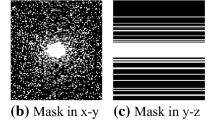Abstract
Application of the compressed sensing (CS) in magnetic resonance imaging (MRI) significantly reduces the scan time as it is capable of recovering images at diagnostic resolution from a few random measurements in the k-space. In 2D multi-slice MRI, a strong inter-slice correlation exists which promotes further reduction in the scan time. In this paper, first, a fast interpolation technique is proposed to estimate missing samples in the k-space of some highly undersampled slices from neighboring low undersampled slices. Next, a novel wavelet tree sparsity based CS reconstruction method is developed for the reconstruction of images from raw 2D multi-slice data. The combination of fast interpolation and CS reconstruction gives accurate reconstruction of multi-slice MR images at significantly less computational time. Simulation results show that the proposed method gives better preservation of edges and other image details with less computational time than some of the recently developed fast CS reconstruction techniques.








Similar content being viewed by others
Notes
References
R. Baraniuk, V. Cevher, M. Duarte, C. Hegde, Model-based compressive sensing. IEEE Transactions on Information Theory 56(4), 1982–2001 (2010)
A. Beck, M. Teboulle, A fast iterative shrinkage-thresholding algorithm for linear inverse problems. SIAM Journal on Imaging Sciences 2(1), 183–202 (2009)
J.T. Bushberg, A.J. Seibert, E.M. Leidholdt, J.M. Boone, The essential physics of medical imaging (Lippincott Williams & Wilkins, Philadelphia, PA, 2012)
E. Candes, M. Wakin, S. Boyd, Enhancing sparsity by reweighted L1 minimization. Journal of Fourier Analysis and Applications 14(5), 877–905 (2008)
E.J. Candes, J.K. Romberg, T. Tao, Robust uncertainty principles: Exact signal reconstruction from highly incomplete frequency information. IEEE Transactions on Information Theory 52(2), 489–509 (2006)
C. Chen, J. Huang, The benefit of tree sparsity in accelerated MRI. Medical Image Analysis 18(6), 834–842 (2014)
C. Chen, J. Huang, Exploiting the wavelet structure in compressed sensing mri. Magnetic Resonance Imaging 32, 1377–1389 (2014)
B. Deka, S. Datta, Advances in Electronics, Communication and Computing, Lecture Notes in Electrical Engineering (LNEE), chap. Weighted Wavelet Tree Sparsity Regularization for Compressed Sensing Magnetic Resonance Image Reconstruction. Springer (2016 (in press))
D. Donoho, Compressed sensing. IEEE Transactions on Information Theory 52(4), 1289–1306 (2006)
A. Hirabayashi, N. Inamuro, K. Mimura, T. Kurihara, T. Homma, Compressed sensing MRI using sparsity induced from adjacent slice similarity. International Conference on Sampling Theory and Applications (SampTA) 2015, 287–291 (2015)
J. Huang, S. Zhang, D.N. Metaxas, Efficient MR image reconstruction for compressed MR imaging. Medical Image Analysis 15(5), 670–679 (2011)
M. Lustig, D. Donoho, J.M. Pauly, Sparse MRI: The application of compressed sensing for rapid MR imaging. Magnetic Resonance in Medicine 58, 1182–1195 (2007)
M. Lustig, D.L. Donoho, J.M. Pauly, Multi-slice compressed sensing imaging. In: International Society for Magnetic Resonance in Medicine, vol. 15, p. 828 (2007)
D.W. McRobbie, E.A. Moore, M.J. Graves, M.R. Prince, MRI from Picture to Proton, 2nd edn. (Cambridge University Press, Cambridge, UK, 2006)
Y. Pang, J. Jiang, X. Zhang, Ultrafast fetal MR imaging using interpolated compressed sensing. In: Proceedings International Society for Magnetic Resonance in Medicine 2014, p. 2224 (2014)
Y. Pang, B. Yu, X. Zhang, Enhancement of the low resolution image quality using randomly sampled data for multi-slice MR imaging. Quantitative Imaging in Medicine and Surgery 4(2), 136–144 (2014)
Y. Pang, X. Zhang, Interpolated compressed sensing MR image reconstruction using neighboring slice k-space data. In: Proceedings of the 20th Annual Meeting of ISMRM, p. 2275. Melbourne, Australia (2012)
Y. Pang, X. Zhang, Interpolated compressed sensing for 2D multiple slice fast MR imaging. Ed. Jonathan A. Coles. PLoS ONE 8(2), 1–5 (2013)
Author information
Authors and Affiliations
Corresponding author
Rights and permissions
About this article
Cite this article
Datta, S., Deka, B. Magnetic resonance image reconstruction using fast interpolated compressed sensing. J Opt 47, 154–165 (2018). https://doi.org/10.1007/s12596-017-0428-8
Received:
Accepted:
Published:
Issue Date:
DOI: https://doi.org/10.1007/s12596-017-0428-8




